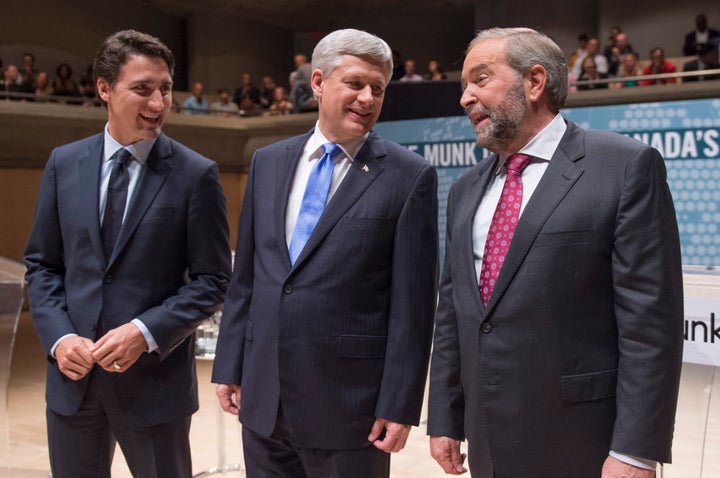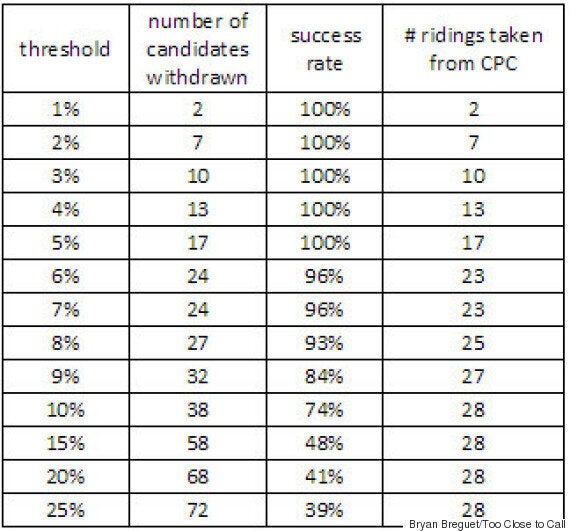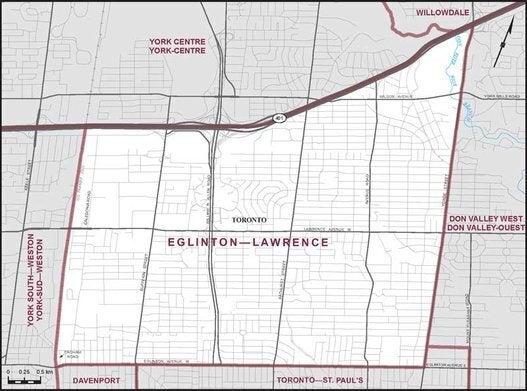Monday was the deadline for the nomination of candidates. The Conservatives, NDP and Liberals are running a full slate of candidates in the 338 ridings. This isn't surprising, as major political parties usually contest every riding — not that they expect to win them all, but for appearances.
The New Democrats and Liberals, however, are fishing in a similar pool of voters: the 60-65 per cent of the population who want a change of government.
The Conservatives, on the other side, seem to have a smaller pool of voters, but they currently get almost 100 per cent of them.
And the Tories have a really high chance of winning the most seats, even though that wouldn't guarantee that Stephen Harper would remain prime minister.
This can be explained partly because of what is commonly referred to as vote splitting. In other words, the electoral system being what it is, there are ridings where a Conservative candidate can be elected even though the sum of votes for the Liberal and NDP candidates is higher.
In a campaign with many people simply trying to get rid of Harper, such vote splitting can be seen as inefficient and can lead to strategic voting. You even have websites dedicated to this issue, such as LibDemo (which also looks at the effect of the Green party) or Vote Together.
According to the latest projections, there are 72 electoral districts where such a situation is occurring. In 2011, there were 46 ridings in the same situation based on official results.

Justin Trudeau, Stephen Harper, and Thomas Mulcair chat prior to the Munk debate on foreign policy. (Nathan Denette/CP)
In order to avoid this problem, the Liberals and NDP could merge. After all, this is exactly what Canada's right-wing parties did in 2003 when the Progressive Conservatives and the Canadian Alliance joined forces. The union didn't lead Harper to power immediately, but he took the prize three years later in the 2006 election.
Even though some discussions took place, it seems unlikely that the NDP and Liberals will merge in the foreseeable future (or ever, really) or even contrive a formal coalition. Nevertheless, it doesn't mean they can't do anything to at least mitigate the effects of vote splitting.
An easier solution than a merger or a coalition would be for the two parties to agree to withdraw some candidates from some ridings.
Specifically, the Liberals could decide to withdraw their candidates in ridings where they have no chance of winning and the NDP is close behind the Conservatives. The NDP could do the same in other ridings. Such a strategy is used in many countries around the world that have not adopted proportional representation.
NDP, Liberals are each other's main second choice
The two-fold question is really: How many candidates would have to be withdrawn and how many ridings would the Conservatives lose? Such a strategy would obviously not lead to the Tories' losing all 72 ridings mentioned above. That is because not all Liberals and NDP voters would fall in line and vote for the candidate of the other party. For instance, we can easily imagine some Liberal voters who would rather switch to the Conservatives than vote NDP. Or they might choose not to vote at all.
The risk is real and hard to exactly quantify based on the data we have. Still, we have strong indicators that most voters would indeed bow to the party's wishes. First of all, the numbers clearly show that the NDP and Liberals are each other's main second choice. Specifically, as many as 48 per cent of NDP voters outside Quebec have the Grits as second choice. At the same time, the Tories are the second choice of less than 15 per cent of Liberal or NDP partisans.
While these choices could be different if the parties were to really make such a deal, it remains likely that most voters would indeed switch to the other one. Moreover, support for a coalition between the two centre-left parties is high — at almost 60 per cent (although a Liberal-led coalition is slightly preferred to a NDP-led one).
It doesn't seem to be much of a stretch to assume that such a deal between Trudeau and Mulcair could work and wouldn't alienate a majority of their supporters. If anything, we just haven't seen evidence that voters of these two parties wouldn't accept such an agreement. But as usual, keep in mind that we are mostly simulating what could happen.
So, how many ridings? The key factor here is the lead the Conservative candidate currently has over the second place. For instance, in a riding like Ontario's Glengarry–Prescott–Russell, where the Liberal candidate is projected less than three points behind, the withdrawal of the NDP candidate — projected at 16 per cent — would guarantee a Liberal victory. In other ridings, the Conservative's lead is simply too big to overcome.
The table below shows the success rate and the number of ridings lost by the Tories as a function of the threshold used by the two parties to determine when to withdraw a candidate. For instance, if they choose to make such a deal whenever the Tories have a lead of fewer than five points, the NDP would end up withdrawing 11 candidates and the Liberals six. All 17 ridings would then be taken away from the Conservatives, for a success rate of 100 per cent.

On the other hand, if they were to run a single candidate in all the 72 ridings, that would only allow a gain 39 per cent of these seats and defeat 28 Conservative candidates.
What comes from this exercise is that the NDP and Liberals could realistically cost the Conservatives 20 to 25 seats if they were to make a deal. Getting any more would require more than double the number of candidates be withdrawn with very little chance of success. Therefore, out of the 72 ridings, only 28 can really be considered to be won by the Tories thanks to vote splitting.
Let's go with a specific — but hypothetical — scenario where Liberals and NDP run a single candidate whenever the Conservatives have a lead of eight points or fewer. This would mean 10 Liberals candidates and 17 NDP would have to withdraw. In this scenario, this pseudo-coalition would regain as many as 25 seats out of 27.
Such an agreement between parties won't happen this election.
It would also be quite difficult to negotiate such a deal — not least because the NDP might have to withdraw twice as many candidates as the Liberals. Choosing the ridings would also be no simple task. While we can expect parties to have seat projection models (or at least to read the projections available), it remains that the ridings where vote splitting occurs are a function of the voting intentions. For instance, in our scenario above, out of the 27 ridings, only six would have been chosen based on the vote intentions of a month ago.
So, vote splitting does exist and it is currently looking like it will cost the Liberals and NDP a significant number of seats — enough to make the difference between Harper finishing third and first.
Both Trudeau and Mulcair could well feel the impact on Oct. 19.

Bryan Breguet has a B.Sc in economics of politics and a M.Sc in economics from the University of Montreal. He founded TooCloseToCall.ca in 2010 where he provides electoral analysis and projections. He has collaborated with the National Post, Journal de Montreal and l’Actualité.
He will provide analysis and updates for The Huffington Post Canada throughout the federal election campaign. For riding by riding projections, visit his interactive simulator.
Also on HuffPost
